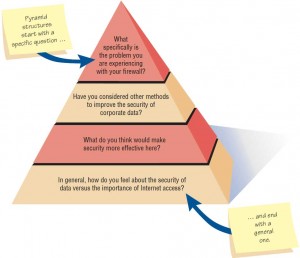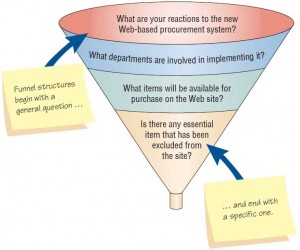Just as there are two generally recognized ways of reasoning—inductive and deductive—there are two similar ways of organizing your interviews. A third way combines both inductive and deductive patterns.
Using a Pyramid Structure
Inductive organization of interview questions can be visualized as having a pyramid shape. Using this form, the interviewer begins with very detailed, often closed, questions. The interviewer then expands the topics by allowing open-ended questions and more generalized responses, as shown in Figure 1 below.

A pyramid structure should be used if you believe your interviewee needs to warm up to the topic. Using a pyramid structure for question sequencing is also useful when you want an ending determination about the topic. Such is the case in the final question, “In general, how do you feel about the security of data versus the importance of Internet access?”
Using a Funnel Structure
In the second kind of structure, the interviewer takes a deductive approach by beginning with generalized, open-ended questions and then narrowing the possible responses by using closed questions. This interview structure can be thought of as funnel shaped, as that depicted in Figure 2. Using the funnel structure method provides an easy, nonthreatening way to begin an interview. A funnel-shaped question sequence is also useful when the interviewee feels emotional about the topic and needs freedom to express those emotions.

Using a Diamond-Shaped Structure
Often a combination of the two structures, resulting in a diamond-shaped interview structure, is best. This structure entails beginning in a very specific way, then examining general issues, and finally coming to a very specific conclusion, as shown in Figure 3.

The interviewer begins with easy, closed questions that provide a warm-up to the interview process. In the middle of the interview, the interviewee is asked for opinions on broad topics that obviously have no “right” answer. The interviewer then narrows the questions again to get specific questions answered, thus providing closure for both the interviewee and the interviewer. The diamond structure combines the strengths of the other two approaches but has the disadvantage of taking longer than either other structure.
The end of the interview is a natural place to ask one key question: “Is there anything we haven’t touched on that you feel is important for me to know?” Considered a formula question by the interviewee most of the time, the response will often be “No.” You are interested in the other times, when this question opens the proverbial floodgates and much new data are presented, though.
As you conclude the interview, summarize and provide feedback on your overall impressions. Inform the interviewee about the subsequent steps to take and what you and other team members will do next.Ask the interviewee with whom you should talk next. Set up future appointment times for follow-up interviews, thank the interviewee for his or her time, and shake hands.
Contents
- Interviewing in Information Gathering
- Five Steps in Interview Preparation
- Open-Ended and Closed Type Interview Questions
- Arranging Interview Questions in a Logical Sequence
- Joint Application Design (JAD) in Information Gathering
- Using Questionnaires in Information Gathering
- Writing Questions for Questionnaires
- Using Scales in Questionnaires
- Designing and Administering the Questionnaires
